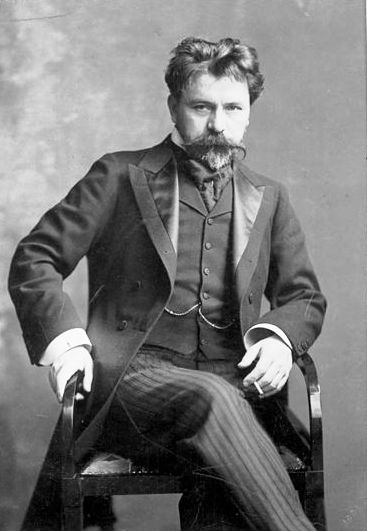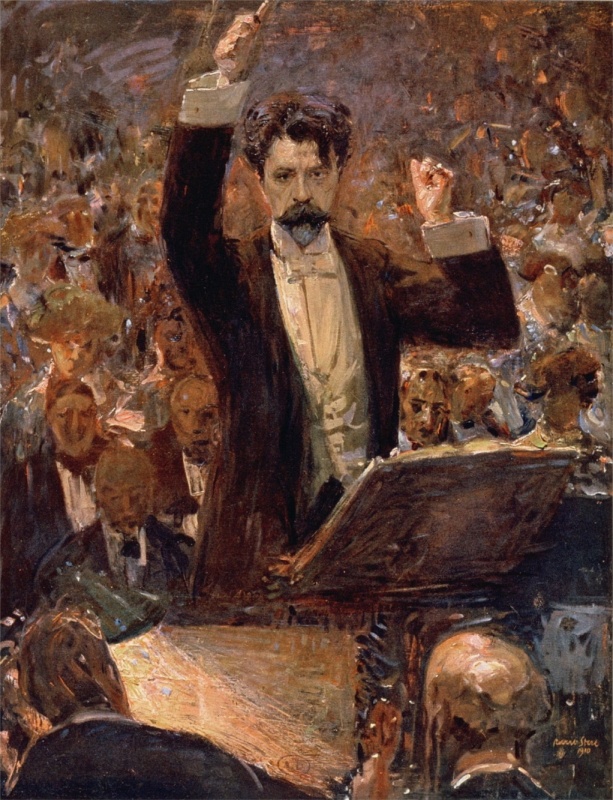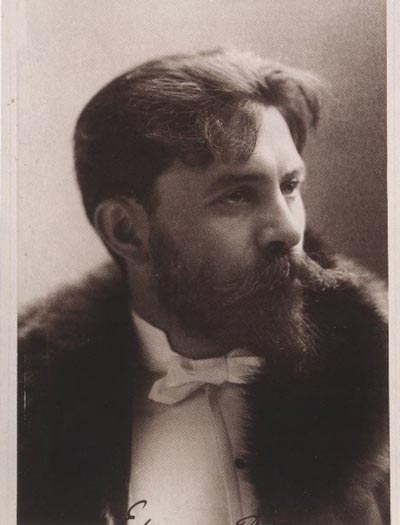The great German master of the baton, Wilhelm Furtwängler, who succeeded Arthur Nikisch as the musical director of the Berlin Philharmonic and the Leipzig Gewandhaus Orchestra, considered his predecessor as one of the greatest conductors in history and his personal role model. The brilliant Nikisch had a profound impact on leading 20th-century conductors, including Arturo Toscanini and Adrian Boult. His pupil was Mieczysław Karłowicz himself, one of the most outstanding Polish composers of the Romantic period. Nikisch also left behind exquisite recordings that have had a lasting impact on the history of music.
Adam Bielecki

Arthur Nikisch in a photograph from 1901. Photo: public domain
Arthur Nikisch was born on 12 October 1855 in the village of Lébényszentmiklós (currently Mosonszentmiklós), located in north-eastern Hungary, as one of the five children of August Nikisch (1820–1897) and Barbara Roboz (1823–1892). As is usually the case with outstanding artists, Arthur's talent was unmistakable from his early childhood. He received his first music lessons from private tutors. In 1866, he began his studies at the Vienna Conservatory. There he studied violin under the Austrian violinist, conductor and teacher Josef Hellmesberger I (1828–1893), who belonged to the famous Viennese dynasty of notable conductors. The young Hungarian was taught composition by the German composer and conductor Felix Otto Dessoff (1835–1892). The Austrian Johann von Herbeck (1831–1877) was also one of his tutors. Arthur Nikisch proved himself as an outstanding student and received numerous awards in the course of his studies.
He began his musical career as a violinist – Arthur played the violin during the performance of Symphony No. 9 in D minor Op. 125 by Ludwig van Beethoven under the baton of Richard Wagner himself as well as during the world premiere of Anton Bruckner's Symphony No. 2 in C minor, often referred to as the "Symphony of Pauses". Eventually, however, he devoted himself entirely to conducting. In 1878, he was appointed the second conductor of the Leipzig Opera and later held the position of principal conductor and general musical director (Generalmusikdirektor in German). From 1889 to 1893, he held the same position in the famous Boston Symphony Orchestra, which he headed during many concerts given across the United States. Despite his dazzling career overseas, Nikisch was faithful to his homeland for the rest of his life. In 1893, he took on the role of the musical director of the Royal Hungarian Opera, founded in 1884. It is currently known as the Hungarian State Opera. He then became the musical director of the Berlin Philharmonic (Berliner Philharmoniker in German) and of the Gewandhaus Orchestra (Gewandhausorchester) in Leipzig, and was a guest conductor at the Dutch Royal Concertgebouw Orchestra and the Vienna Philharmonic. From 1912 to 1914, Arthur Nikisch was the principal conductor of the London Symphony Orchestra, and the successor of Edward Elgar in this role. Nikisch also worked as a tutor – he was the director of the Royal Conservatory of Music of Leipzig, and in 1906 Mieczysław Karłowicz took a conducting course under Nikisch.

Arthur Nikisch conducting an orchestra during a concert in Leipzig – painting by the German painter and graphic artist Robert Hermann Sterl (1867–1932). Photo by Public domain
Nikisch's extraordinary conducting skills made a great impression on Pyotr Tchaikovsky, who had the opportunity to hear the 32-year-old's interpretations in 1887: "Mr Nikisch is elegantly calm, economical in his movements, yet powerful and composed. He does not seem to be conducting but rather casting some arcane spells. [...] He never tries to draw attention to himself, and yet we feel that the great orchestra, like an instrument in the hands of a great master, is completely under his sway."
A rare recording dating from 1913, with Arthur Nikisch conducting. Source: YouTube
The impeccable performance of Tchaikovsky's Symphony No. 6 in B minor "Pathétique" Op. 74, which Nikisch conducted in 1896, inspired Nikolai Myaskovsky (1881–1950), one of the most outstanding 20th-century symphonists, to abandon his military career to fully dedicate himself to composing. Another famous admirer of Nikisch's interpretations was Johannes Brahms (1833–1897), who greatly appreciated, among others, the performance conducted by Nikisch of the Symphony No. 4 in E minor, Op. 98. It was composed by Brahms in 1884, and together with Symphony No. 3 in F Major, Op. 90, it is widely regarded as the best of his entire musical output.

Arthur Nikisch in a photograph from 1893. Photo: public domain
Arthur Nikisch died on 23 January 1922 in Leipzig at the age of 66. He is buried in Leipzig's Südstadt Cemetery. His son Mitja Nikisch (1899–1936) inherited his father's musical talent and built himself a career as a pianist and composer. He left behind, among others, an accomplished piano concerto completed in 1936, right before his premature death.
Due to technical limitations, which is natural given the age of the musical pieces, relatively few recordings of the works interpreted by Arthur Nikisch have survived till this day. Moreover, the sound quality leaves much to be desired from the perspective of a modern music enthusiast. However, regardless of their quality, these recordings showcase the pure genius of this excellent Hungarian conductor. The first recorded symphonic piece conducted by Nikisch was the Egmont, Op. 84 Overture in F minor, composed in 1810 by Ludwig van Beethoven. This work is one of the ten pieces of music by this composer created for "Egmont" – a play by Johann Wolfgang von Goethe. This overture was performed by the British London Symphony Orchestra on 28 June 1913 at the Gramophone Company's headquarters in Hayes, located in the London Borough of Hillingdon.
Recording of the concert overture Egmont, Op. 84 in F minor composed by Ludwig van Beethoven and performed by the London Symphony Orchestra under the baton of Arthur Nikisch. Source: YouTube
In 1913, Nikisch conducted the performance of Symphony No. 5 in C minor, Op. 67 by Ludwig van Beethoven (1808), which made music history as one of the first commercial recordings of a complete symphony and the first-ever recording of a symphony conducted by a world-famous conductor. The first recording of a symphony was conducted by the German conductor Friedrich Kark in Berlin in 1910, conducting the Odeon Symphony Orchestra. Moreover, it was one of the first attempts to capture the natural sound of a full orchestra inside the studio, without substituting instruments considered too challenging to record at the time, as was common practice in the early 20th century.
Most symphonic works, composed for the standard composition of the orchestra, were arranged so that the string parts were performed by woodwind and brass instruments. The Stroh violin (also known as Stroviol) invented in 1899 by electrical engineer John Matthias Augustus Stroh, which was a violin with a metal resonator horn, was supposed to partially solve this problem.
The famous recording of Symphony No. 5 in C minor, Op. 67 composed by Ludwig van Beethoven and performed by the Berlin Philharmonic under the baton of Arthur Nikisch. Source: YouTube
Nikisch was also renowned for his excellent interpretations of works by Hector Berlioz. Overtures occupy an important place in the oeuvre of this French composer, and it is one of them, Roman Carnival, Op. 9 (Le carnaval romain), composed in 1844, that can be heard as interpreted by the prominent Hungarian conductor. The recording of this wonderful musical piece in A major dates from 1920.
Recording of the concert overture Roman Carnival, Op. 9 (Le carnaval romain) composed by Hector Berlioz and performed by the Berlin Philharmonic under the baton of Arthur Nikisch. Source: YouTube
The musical legacy of the Hungarian maestro also includes recordings of the performances of works composed by his compatriots. One of them is Franz Liszt's interpretation of the Hungarian Rhapsody No. 1 in F minor, dating from 1914. The numbering of the piece may initially cause confusion, as it is, in fact, an orchestrated 14th Hungarian Rhapsody for the piano by the same composer.
Hungarian Rhapsody No. 1 in F minor composed by Franz Liszt and performed by the London Symphony Orchestra under the baton of Arthur Nikisch. Source: YouTube
Also noteworthy is the 1913 recording of the overture to Oberon: Opera in Three Acts from 1826 (J. 306 – the number assigned to the opera according to the Friedrich Wilhelm Jähn's catalogue) by the German composer Carl Maria von Weber. This opera, with a libretto based on the epic poem of the same title by Christoph Martin Wieland, together with another three-act opera, Der Freischütz, composed five years earlier, is probably the most famous work of this outstanding composer. Nikisch's interpretation, despite the fact that more than a century has passed since it was recorded, continues to impress with its electrifying energy.
A recording of the overture of Carl Maria von Weber's Oberon: Opera in Three Acts performed by the London Symphony Orchestra under Arthur Nikisch. Source: YouTube
Bibliography:
Chevalley Heinrich, Arthur Nikisch: Leben und Wirken, Bote & G. Bock, Berlin 1922.
Dette Arthur, Arthur Nikisch, Dearbooks, Bremen 2014.
Schönzeler Hans-Hubert, Horowitz Joseph, Nikisch, Arthur [in:] The New Grove Dictionary of Music and Musicians, London 2001.
Лариса Михайловна Кутателадзе, Артур Никиш и русская музыкальная культура: воспоминания, письма, статьи, Музьыка, Leningrad 1975.
